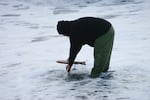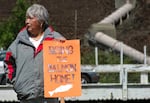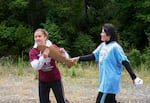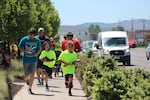For more than 120 years, four dams have had a chokehold on the Klamath River.

Hoopa Valley High School students and community members gather at Iron Gate Dam in 2006. From left to right: Kayla (Carpenter) Begay, Erika (Chase) Tracy, Melodie George-Moore, Natalie (Carpenter) Scott, Jesika (Mitchell) Sheaf, Lois Risling, Tasha (Norton) James, Marcellene Norton.
(Photo courtesy of Seventh Generation Fund for Indigenous Peoples)
In 2002, a massive fish kill left over 70,000 salmon floating belly up in the river, dead from diseases that flourish in waters drained low by drought and agricultural diversions.
Dr. Kayla Begay, then a freshman at Hoopa Valley High, remembers the incident well.
“Nobody in our lifetime had seen something like that happen, where so many fish died before they ever got to spawn,” said Dr. Begay, now Assistant Professor of Native American Studies at Cal Poly Humboldt.
Begay decided to do something about it.
Begay joined forces with fellow Hoopa Valley tribal citizen Tasha James and their classmates Erika Chase, a Hoopa Valley tribal citizen and of Shinnecock descent, and Chelsea Reed, a citizen of the Yurok Tribe.
The four high school freshmen founded a ceremonial run to call attention to the need to remove the dams. In the early years, the run was a short community event. Now, it has grown to encompass the entire river, from its mouth in the Pacific Ocean to its headwaters near Upper Klamath Lake. The run spans about 350 miles, including a leg along a tributary.

Salmon Run participants hold carved wooden salmon and signs that read "Bring the Salmon Home!"
Courtesy of Seventh Generation Fund for Indigenous Peoples
Long before European settler contact, salmon runs like this one united Klamath communities up and down the Klamath River Basin. Today, the run unites the tribal nations whose ancestral lands include the river, in their quest to save the fish that have provided for their peoples for thousands of years.
“The connection to the river runs in our blood,” said James, who today works for the Yurok Tribe as Temporary Assistance for Needy Families Program Manager. “Look at your hand. Look at your veins. That is a resemblance to the rivers that we come from. To see something so personal, and something we are so connected to just dying, ultimately, we knew we had to do something.”
The group sprung into organizing the inaugural Salmon Run in 2003, with help from Yurok citizen Margo Robbins, who was then an adviser for the Hoopa High Water Protectors Club.
Their efforts coincided with far-reaching political, scientific and conservation work by the Klamath, Karuk, Hoopa Valley and Yurok tribes, which together launched a massive and ultimately successful campaign to remove the four Klamath River dams.
In May, the four tribes will celebrate the 20th anniversary of the Salmon Run, by making the over 340-mile journey from the mouth of the river on the California coast, maneuvering up to the headwaters in southern Oregon.

Leo Canez, Yurok Nation, starts the Salmon Run journey by saying a prayer as he dips a carved wooden salmon into the waters of the mouth of the Klamath River.
Courtesy of Seventh Generation Fund for Indigenous Peoples
The run will take place over four days. But this year, things will be different.
“This year is actually going to be the last official year that all four of the dams are still going to be standing,” said Crispin McAllister, an avid runner and former Karuk Tribal Councilman.
Preparation for the planned September demolition of the Copco 2 Dam is already underway. The work was approved as part of the Klamath Hydroelectric Settlement Agreement, a historic cooperative agreement that included PacifiCorp, state agencies and tribes. Together, they formed the Klamath River Renewal Corporation, the nonprofit in charge of dismantling the four dams.
The Federal Energy Regulatory Commission approved the $450 million dam removal project in November 2022. After the first dam is removed in September, the other three will come down by the end of 2024, making it the largest dam removal project in the world.
The Klamath River will flow free once again, and the salmon will finally return home.

During the third annual Salmon Run, an elder stands in front of Iron Gate Dam holding a "Bring the Salmon Home" sign.
Courtesy of Seventh Generation Fund for Indigenous Peoples
A call for prayer and action
The project will restore hundreds of miles of salmon spawning habitat that has been blocked by dams for generations.
Annelia Hillman, an activist, key organizer of the annual run and a citizen of the Yurok Tribe, says the young organizers of the original run had a vision of how to best bring awareness to the damaged state of the Klamath River.
“What happened to our salmon called for prayer and action,” Hillman said.
Hillman said the run is a celebration of the collective efforts to heal the river and the communities that live along it. It’s a healing run, which participants use as an opportunity to pray for their relatives living along the river, including the water, the fish and the people.
Over two decades, the run has grown from a school-led activity to a four-day, 350-mile event.
The course is broken up into one-mile increments, so participants of all ages and abilities can join in. Organizers from the Klamath, Karuk, Hoopa Valley and Yurok tribes plan their section of the run through their traditional villages, which provides an opportunity for participants along the route to represent their distinct communities.
Normajean Cummings, a citizen of the Klamath Tribes, has helped organize the run for eight years. This year’s run, which will take place from May 18 through May 21, is expected to be the largest one yet – with the potential for 1,200 runners.

Runners take turns passing carved wooden salmon batons to the next person as they complete their portion of the race.
Courtesy of Seventh Generation Fund for Indigenous Peoples
Participants take turns carrying carved wooden fish and praying as they complete their portion of the run, before passing the fish along to the next person. The carved fish batons are a symbol of the long-anticipated return of the salmon.
“We’re not just praying for ourselves and for our tribes,” Cummings said. “We’re praying for all of the communities that we run through.”
The runners bring energy and excitement back into the communities year after year, Cummings said.
As an original organizer, Begay says she finds joy in seeing the movement kept alive by new generations of young activists.
“It has never stopped being tied to youth,” Begay said. “I see young people from our community speaking up and still speaking for salmon and going into protests and using their voice to raise awareness.”

Runners carry carved wooden salmon as they run down South 6th Street in Klamath Falls, Oregon on their way to the Klamath River's headwaters in Southern Oregon on May 28, 2017
Courtesy of Normajean Cummings
And Begay says she is excited to see how the run will continue to evolve, even after the dams come down.
“We’re not going to stop,” McAllister said. “We’re going to keep doing this and it’s going to turn into something different afterward, because the salmon are always going to be on our agenda, to see a full healthy recovery for them.”